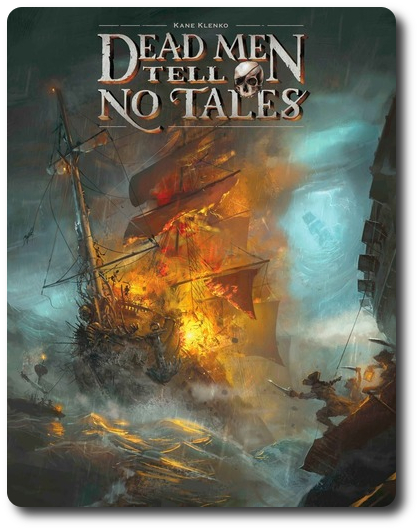
The Basics:
- For ages 8 and up (publisher suggests 13+)
- For 2 to 5 players
- Approximately 75 minutes to complete
Geek Skills:
- Active Listening & Communication
- Counting & Math
- Logical & Critical Decision Making
- Reading
- Pattern/Color Matching
- Strategy & Tactics
- Risk vs. Reward
- Cooperative & Team Play
- Hand/Resource Management
- Worker Placement & Area Control
Learning Curve:
- Child – Moderate
- Adult – Easy
Theme & Narrative:
- When the undead have all the booty, it’s time to kick some skeleton butt
Endorsements:
- Gamer Geek approved!
- Parent Geek mixed!
- Child Geek mixed!
Overview
The cursed ship, Skelit’s Revenge, is crewed by the undead. This ship sails the seven seas looting ships and adding to their crew, leaving few survivors to tell the tale. Your captain is obsessed with finding the Skelit’s Revenge and taking her. You don’t know the captain’s reasons, but the promise of unbelievable wealth is all you need. The risk, however, might be greater than the reward.
Dead Men Tell No Tales, designed by Kane Klenko and published by Minion Games, is comprised of 1 Starting tile, 20 Room tiles, 7 Pirate meeples, 3o Deckhand tokens, 5 Player boards, 24 Fire dice (standard six-sided dice, 12 red, 12 yellow), 1 Battle die (standard six-sided die, black), 20 Room tokens (double-sided), 26 Action tokens (double-sided), 7 Character Battle tokens, 19 Skelit’s Revenge cards, 7 Character cards, 7 Item cards, 1 Dinghy card, 5 Player Aid cards, 1 Explosion marker, 1 Captain Fromm token, and 1 cloth bag. The component quality is excellent. The cards are as thick as your standard playing card and the cardboard bits are thick and durable. The meeples and Deckhand tokens are made of solid wood and painted. Artists Jason D. Kingsley and Chris Ostrowski did a wonderful job of visually mixing swashbuckling action with undead grit.
Prepare to Board!
To set up the game, first place the Starting tile in the middle of the playing area. All Room tiles will be attached to the Starting tile, so make sure there is enough room in the playing area. Place the Explosion maker below the Starting tile. It will be used later in the game.
Second, roll 2 red Fire dice and 2 yellow Fire dice. Place the dice on the designated areas on the Starting tile (will match the color of the die). The Fire dice indicate the intensity of the fire raging on the undead pirate ship. Place the remaining dice, including the black Battle die, and the Dinghy card to one side, within easy reach of at least 1 player.
Third, place 1 Deckhand token on the room area on the Starting tile that has the trapdoor symbol. Place the remaining Deckhand tokens to one side and within easy reach of at least 1 player.
Fourth, shuffle the Skelit’s Revenge cards and place them face-down to form the Skelit’s Revenge draw deck. Then shuffle the Room tiles and place them face-down in a stack, as well. Count the number of players in the game and multiply that number by 2. Draw the same number of the top-most Room tiles without looking at them. For example, if playing with 4 players, you would draw 8 Room tiles. Take the drawn Room tiles, offset them, and place them back on the Room tile stack. The offset tiles should be visibly obvious.
Fifth, take the 20 double-sided Room tokens and place them in the cloth bag and mix them, but remove the Captain Fromm token unless you are playing the game variant.
Sixth, players should now determine the game’s difficulty level. There are three levels of difficulty. These are “Scurvy Dog” (the easiest), “Buccaneer”, and “Admiral” (the most difficult). The difficulty level will determine the number of Treasures the players will need to find in order to win the game.
Seventh, give each player 1 Player board, 1 random Character card, 1 matching Character Battle token, 1 random Item card, 1 Pirate meeple that matches the color of the Character card, and 5 Action tokens. Set the Fatigue Dial on the Player board to “zero”, place the Character card to the left of the Player board, place the Item card to the right of the player board, place the Character Battle token on the “zero” space on the Battle track on the bottom of the Player board, and place the meeple on the Starting tile space that looks like a Dinghy (a small boat).
Eight, place all remaining Item cards face-up on the table and within easy reach of at least 1 player. We’ll call this the “Item pile”.
That’s it for game set up. Time to get some treasure! Determine who will be the first player and begin!
Looting the Undead
Dead Men Tell No Tales is played in rounds and turns. A player’s turn is comprised of 3 phases. A player’s turn is summarized here.
Phase 1: Search the Ship
If this is the player’s first turn, they will draw the 2 Room tiles and attach them to the ship. Otherwise, the player will only draw 1 Room tile. Room tiles must match open doors to any adjacent Room tiles to be properly placed. That is, a door cannot open to a wall, because that would be silly. Additionally, Room tiles cannot have door that opens to the stern of the Skelit’s Revenge.
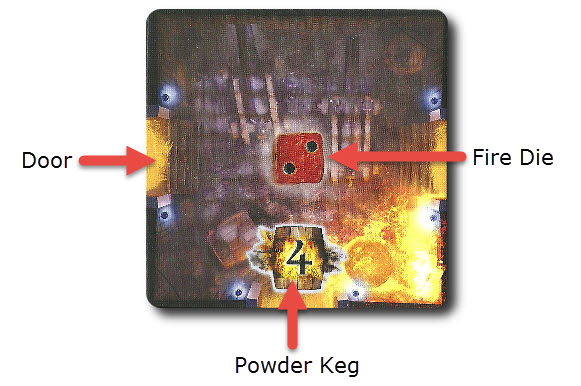
Placement of the Room tile is surprisingly important. Not only does it build the ship the players are searching, but it also determines if the players can win the game or not. If a player cannot correctly place a Room tile on their turn, the players have lost the game. Long story short, don’t put yourself in a corner.
Room tiles should be placed one at a time. When a Room tile has a red or yellow square with a number of dots ranging from 0 to 5, the matching colored die and number of pips is placed on the square space. This indicates the intensity of the fire in the room.
Then the player draws 1 token from the cloth bag. Depending on the token drawn, the player will do the following:
- If a Treasure/Guard token is drawn, place the token on the Room tile with the Guard side face-up.
- If a Skeleton Crew/Cutlass or Skeleton Crew/Grog token is drawn, place the token on the Room tile with the Guard side face-up.
- If a Trapdoor token is drawn, place the token on the Room tile along with 1 Deckhand token. The Trapdoor token should never be covered.
If the player is placing the last Room tile, check to see if a door is open and not connected to any other Room tile. If there is, the players have found an alternative exit from the ship. Place the Dinghy card next to the open door indicating that the Room tile has a safe exit. When players leave through either of the two exits, they may reenter the ship through either entrance, as well.
Phase 2: Pirate Actions
Now that the additional rooms in the ship have been uncovered, it’s time for the player to move their pirate. Each player, by default, starts with 5 actions (or more depending on the Character card). The number of available actions the player has is tracked by the Action tokens. One side is gold and the other side looks like the same gold coin, but smeared with soot or dirt. The player’s use these to keep track of how many actions they have spent and how many they still have left. Each player also has a unique Character card that represents their pirate. Pirates have unique abilities that might come in handy.
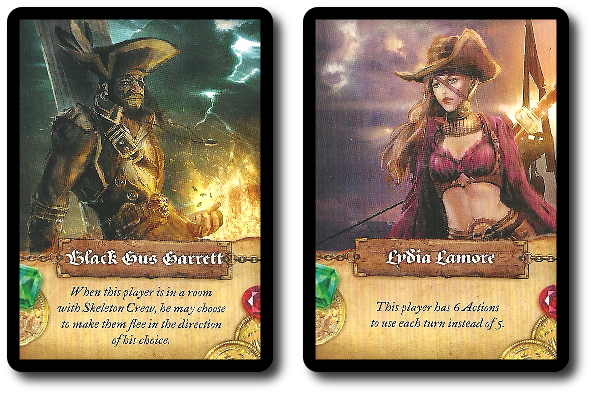
To begin, the player organizes their Action tokens so they are all showing the gold side without the soot. The player then can take any of the following actions and in any order. The player can also take the same action multiple times.
The one exception to this rule is if the player is “Looting”. If a player spends an action to pick up a Treasure, they are considered to be “Looting” and are encumbered. To help the player remember, the Treasure token is placed on the Player board. When the player is “Looting”, they can only take the following actions: Walk, Rest, and Swap Item Card.
All possible actions follow. When the action is taken, 1 Action token is flipped over to the soot side. Any Action tokens not used are passed to the next player in turn order sequence to use. After using Action tokens that were given by another player, turn then over and then return them to the player who gave them to you. Any passed tokens not used are also returned to the owning player at the end of the turn.
Walk
Walking allows the player to move their Pirate meeple from one Room tile to an adjacent Room tile by way of doors. Moving about the ship will cause the player’s pirate to become “Fatigued”. The player’s pirate’s current level of “Fatigue” is tracked using the Fatigue Dial on the Player board.
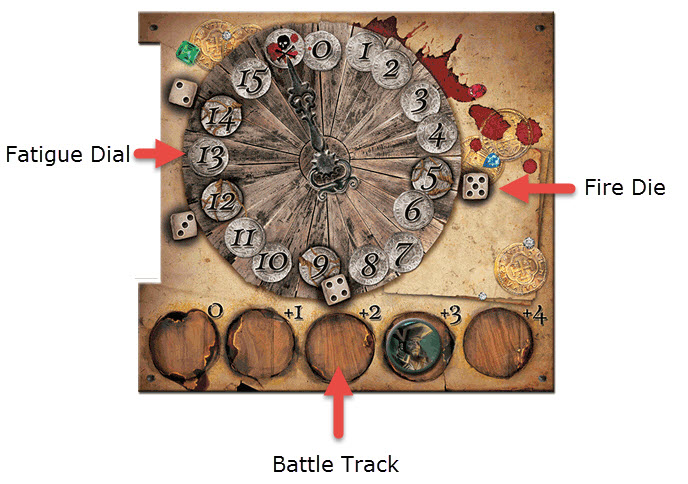
If the Pirate meeple is moved to a Room tile that has a higher valued Fire die than the Room tile they were moved from, the player increases the Fatigue Dial value based on the difference between the exiting Room tile’s Fire die value and the entering Room tiles Fire die value. For example, if the exiting room had a Fire die value of “2” and the Pirate meeple entered a Room tile with a Fire die value of “5”, the different would be “3”. The player would then increase the Fatigue level on the Dial by “3”. Additionally, if a Pirate meeple is ever located in a Room tile where the Fire level increases (due to a wide variety of Fire effects), the Fatigue level will go up by +1.
“Fatigue” is not good. If the Fatigue Dial needle is pointing to or past a Fire die value, the player’s Pirate meeple cannot enter a Room tile that has the same Fire die value or higher. For example, if the Fatigue Dial is past the Fire die value of “4”, the player cannot enter room tiles with a Fire die value of “4” or “5”.
If the Pirate meeple is somehow moved into a Room tile or finds themselves in a Room tile where the Fire die value is equal to or higher than the pirate’s Fatigue level value, then the player must exit the room, fight the fire, or rest until the pirate’s Fatigue level value allows the use of normal actions.
Run
Running is a lot like the Walk action, but faster. The Pirate meeple is moved through 2 Room tiles for 1 action. Doing so allows the player to move through the burning ship at a faster pace, but at a cost. The Fire die values are checked for each room moved to and the pirate’s Fatigue level is adjusted accordingly. In addition, each time the player’s pirate takes “Fatigue”, they take 2 more than usually. This additional “Fatigue” value represents the pirate running through the ship. I guess that means the pirate is out of shape.
So why bother? Running sounds like it takes a toll on the player’s pirate. It does, but it also frees up Action tokens.
Fight Fires
Fighting a fire reduces the Fire die value in the Room tile the player’s Pirate meeple is currently located on. For every 1 Action token spent, the Fire die value is reduced by “1”. If the Fire die value is reduced below “1”, it’s removed and the Room tile is fire-free. Less fire means less “Fatigue” is lost and the risk of an explosion is greatly decreased.
Eliminate a Deckhand
The skeleton Deckhands are the weakest crew members of the Skelit’s Revenge, but they still cause problems. Individually, they are easy to handle, but they can swarm the ship. If a player is ever required to play a Deckhand token and cannot since they are all in use, the player’s lose the game. As such, Deckhands are but one more risk the player’s must manage. Luckily for the players, they are easy to handle. For only 1 Action token, 1 Deckhand token is removed from the same Room tile where the player’s Pirate meeple is located or from 1 adjacent Room tile connected by doors. Removed Deckhands are placed back with the rest of the Deckhand tokens not currently in use.
Pick Up a Token
Helpful tokens will be scattered about the ship which will aid the players in their quest to grab the loot and get off the boat alive. Treasure tokens are the most valuable, as they are key to the players’ victory. Other tokens can be found, as well, that will be most useful. For example, Grog which is much healthier than water and can reduce a pirate’s “Fatigue”. Better yet, drinking some Grog doesn’t take an action, allowing a player to keep a few Grogs on hand for a quick “pick me up” when surrounded by fire.
Tokens, once taken, are placed on the Player board. Tokens cannot be given to another player, but they can be dropped in a room so another player can pick it up. Dropping a token does not coast an action.
When a player picks up a Treasure token, they are considered “Looting”. The Treasure token is placed on the Player board. This serves two purposes. First, to remind the player that they are carrying treasure. Second, “Looting” pirates raise their Fatigue level faster than normal. The pirate’s Fatigue level increases based on the Fire level of the room the Pirate meeples moved onto.
Rest
When the tough gets going sometimes you need a rest. Taking the Rest action lowers the Fatigue level by “2” each time the action is taken. For example, spend 4 Action tokens to Rest and the Fatigue level is reduced by “8”.
A player can also temporarily leave the game by moving their Pirate pawn to an exit point. The first phase of the player’s turn immediately ends and any unused Action tokens must be passed to the next player. In return, the player reduces their current Fatigue level by half. When it’s the player’s turn again during phase 1, they will enter the ship at any entrance point.
Increase Battle Strength
Every pirate starts the game with a Battle Strength of “0”, which is tracked on the Player board. For 1 Action token, the player can improve their Battle Strength by “1” for a maximum of “+4”.
Swap Item Card
Each player is given an Item card at the start of the game, but it might not be the best Item card to have. For 1 Action token, the player can swap their Item card for any Item card not yet claimed or from another player, if the player agrees to the swap. If not swapping with a player, any available Item card in the Item pile can be taken. The new Item card is placed by the Player board and the previously owned Item card is placed in the Item pile. If swapping with a player, the previously owned Item card is placed in the Item pile and the other player’s Item card is taken. The player who does not have an Item card now selects 1 Item card from the Item pile out of turn and without spending an action. It should also be noted that newly acquired Item cards can be used immediately on a player’s turn!
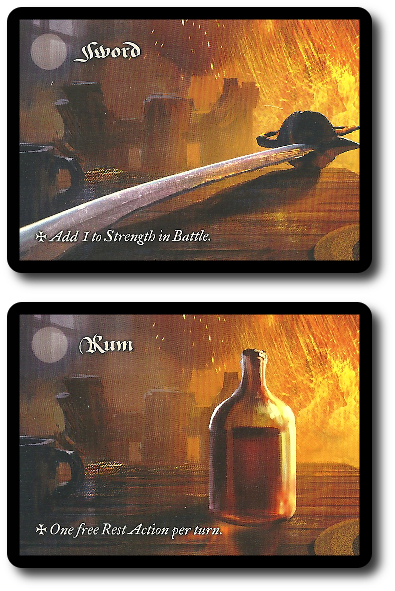
Phase 3: Skelit’s Revenge!
After the player has taken their actions and passed any unused Action tokens to the next player in turn order sequence, the skeleton crew attack. The top-most Skelit’s Revenge card is drawn and place face-up, read, and resolved. Lots of nasty things could happen and each “nasty thing” is resolved starting at the top of the Skelit’s Revenge card to the bottom of the list. Each Room tile is adjusted as needed, starting with the lower-left most room and moving across. Then the next lower-left most Room tile is adjusted and so on. The last Room tile to be changed will always be the top-right most Room tile.
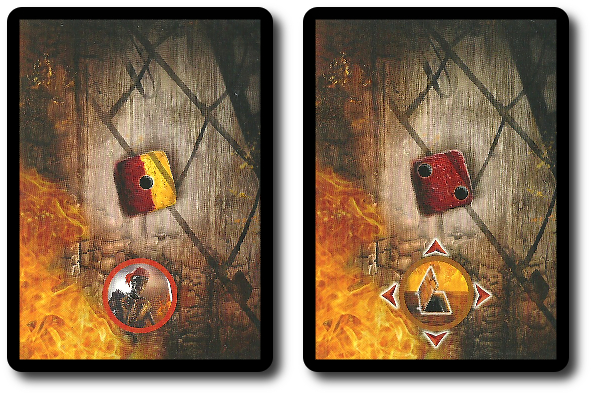
Possible problems include the following:
Fire, Fire Everywhere!
If the Skelit’s Revenge card shows a yellow, red, or both Fire dice, any and all dice that match the same color and number shown on the card increase their current value by +1. For example, a “4” would increase to “5”. If the card shows a colored die without a number value, add 1 die to each Room that matches the same color with a value of “1”, but only to a Room tile that DOES NOT have Fire die already placed on it.
If a Room tile has an image of a Powder Keg with a number value, the room could explode. If the Fire die located on the Room tile ever has the same or greater value than the Powder Keg value, the Room tile explodes. The resulting explosion rockets out of the closest Room tile door next to the Powder Keg and raises the Fire level in the adjacent Room tile by +1. This means it’s perfectly possible to have a chain reaction of multiple exploding Powder Kegs if the players are not careful. Thankfully, Powder Kegs can only explode once in each Room tile per game.
A Room tile will also explode if the Fire level on the Fire die is ever raised to “6”. The effects are the same as a Powder Keg blowing up, but worst. When a Room tile explodes, the blast exits EVERY door, impacting the Fire level of all adjacent Room tiles that are connected via a doorway. Worse yet, when the Room tile explodes, any one or thing within it is out for the duration of the game. This includes treasure, undead crew, and unfortunate pirates. The Room tile is flipped over and now becomes impassable, possibly cutting off large sections of the undead ship.
Explosions of any type are bad news for the players. Each time a Powder Keg or a Room tile goes “boom”, the Explosion marker on the Explosion track moves 1 step forward. If the Explosion marker moves to the “Skull and Crossbones” symbols, the game is over and the players have lost.
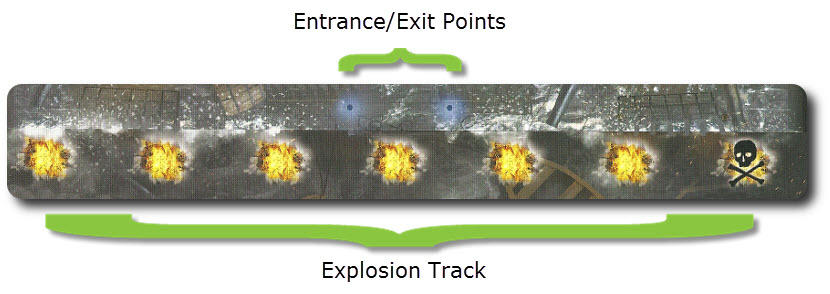
All Skeleton Hands on Deck!
The Deckhand tokens will either swarm out of the belly of the undead ship through Room tiles that have trapdoors or added to an adjacent rooms. There is no limit to the number of Deckhand tokens a Room tile can hold when they emerge on deck, however, Deckhands will only be added to a Room tile if the total number of Deckhands is currently fewer than the total number of Deckhands in the Room tile where the token is currently located. Nor will Deckhand tokens move to a Room tile that has a trapdoor, meaning the Deckhands will begin to bunch up fairly quickly. It’s also important to note that Deckhand tokens never “move”. They are added to Room tiles, making it easy for players to determine where the Deckhand tokens may appear, but this also means the Deckhand token pile will quickly be reduced.
Individual Deckhand tokens are not much of a threat. A single Deckhand token on a Room tile does not stop a player from doing anything. If there are 2 Deckhand tokens, the Room tile gets a big crowded and a player can no longer pick up any tokens on the Room tile. If there are 3 or more Deckhand tokens, the Room tile cannot be entered. If a Pirate pawn is located on a Room tile with 3 or more Deckhand tokens, the player must either exit the Room tile or spend their actions removing Deckhand tokens until only 2 or fewer remain.
Players will want to keep the Deckhand level down to a minimum at all times. If a player is ever unable to place a Deckhand token during their turn because all the tokens are in use, the pirates are overwhelmed and crush. The player’s lose the game and the undead add new members to their crew.
Shambling Bones
The undead Deckhands are bothersome, but the more elite undead Skeleton Crew are very aggressive. When the Skelit’s Revenge card shows the Skeleton Crew tokens move, all Skeleton Crew tokens move to 1 adjacent Room tile in the direction of the nearest Pirate pawn. Which will most likely lead to a battle.
This ends the player’s turn. The next player in turn order sequence now goes repeating the phases noted above. If the player has any unused Action tokens, they may pass them to the next player now. Any Action tokens given to the player are returned to their owner now, as well.
Battling the Undead, Pirate Style!
Combat will occur if the player wants to take a Treasure token from an undead Guard or the Pirate pawn is located on a Room tile with 1 or more Skeleton Crew tokens.
If a player finds their Pirate pawn located on the same Room tile as a Skeleton crew token, they must battle the Skeleton crew. This happens immediately, even if it isn’t the player’s turn. Battling the Skeleton Crew never costs an action, but pirates cannot battle and carry treasure at the same time, or spend Action tokens to improve their battle abilities. This means Treasure tokens currently in possession of a pirate must be dropped while fighting the undead. This only applies to the Skeleton Crew, not Deckhands.
Battles are very simple. The player rolls the Battle die and adds to the rolled value their current bonuses provided by their Battle track and Item card. This number is compared to the Skeleton Crew token number value. If the player’s Battle number is equal to or greater than the Skeleton Crew’s Battle number, the player wins. The Skeleton Crew token is flipped over and remains on the Room tile. Whatever the token represents can not be picked up.
If the player’s Battle number is less than the Skeleton Crew’s Battle number, the player has lost the battle and increases their Fatigue level equal to the difference between the Battle numbers. For example, if the player rolled a “2” and the Skeleton Crew Battle number is a “6”, the difference would be “4”. The Battle die is then rolled again to determine the battle’s outcome. This could result in the Skeleton Crew token moving to another Room tile, the pirate retreating, or another round of combat.
The “Guard” Skeleton Crew are unique. They hold and guard the Treasure tokens. Actually, they are the Treasure tokens (on the other side of the token). Guards will never move and will fight to keep the treasure until they are destroyed or the player’s pirate falls. Battling a Guard is similar to battling any other Skeleton Crew with one exception. If the player loses the battle, they increase their Fatigue level as normal, but do not roll to randomly determine the battle’s outcome. Instead the player can decide if they want to fight the Guard again or retreat to an adjacent Room tile.
If there are multiple Skeleton Crew tokens on the same Room tile as the player’s Pirate pawn, the player must announce which Skeleton Crew they are fighting before rolling. The battle must continue until all the Skeleton Crew have been taken care of, the pirate dies in combat, the Skeleton Crew move to another Room tile, or the pirate retreats.
Battle Track and Cutlasses
The Battle track value is added to the player’s rolled Battle die value. However, once it’s added, the Battle track is reset to “zero”. A player is never required to use their Battle track if they do not want to and they do not have to decide if they want to use it until after they roll the Battle die. They must use all of it or none of it, however. The player can later use Action tokens to increase their Battle track modifier, making it something of a battery that stores combat energy. Once tapped it’s completely drained and must be charged again.
The Cutlass token can be used to permanently increase a pirate’s battle skills. Picked up Cutlass tokens are placed on the lowest Battle track value and occupy it, moving the Battle token to the next highest track value. When the Battle track is reset after use in battle, the Battle token is moved to the lowest Battle track value not occupied by a Cutlass token. This means a player’s pirate can really beef themselves up, but there are only 5 Cutlass tokens in the game, which need to be found, and there are plenty of players who want to use the Cutlass themselves. There is no limit to the number of Cutlass tokens a player can have, but one should not use them all if they hope to win the game with their fellow pirates.
When Good Pirates Die Badly
If a player’s Pirate pawn is unfortunate enough to be located in an exploding Room tile or the Player board Fatigue level reaches the “Skull and Crossbones” symbol, the pirate is no more. The player, however, continues the adventure by completing the following steps:
- Remove Pirate pawn from it’s current Room tile location
- Remove Character card from the game and draw a new one
- Remove Item card from the game and draw a new one at random
- Discard all Cutlass and Grog tokens
- Reset Player board (Battle track and Fatigue Dial set to “zero”)
- If the pirate died from exhaustion (Fatigue level moved to “Skull and Crossbones”), any carried Treasure tokens remain on the Room tile or if the Room tile exploded, the Treasure tokens are removed from the game
- Place the Pirate pawn on the entrance to the Skelit’s Revenge and continue playing on your next turn as normal
Dead Men or Rich Men
If the players can remove (via Run or Walk) a number of Treasure tokens from the undead ship equal to the difficulty level the player’s selected and all the pirates make it off the ship safely, they have succeeded. This is the only way the players can win the game.
The players can lose all kinds of different ways. If the Explosion marker moves to the last space on the Explosion track, if the players cannot place any more Deckhand tokens, if a Room tile cannot be legally placed, if enough Treasure tokens are lost making it impossible for the players to “Loot” their required amount, if a pirate dies after all the required Treasure tokens are looted, or if a pirate dies and there are no more Character cards left to play, the players have lost.
Game Variants
As if the game wasn’t difficult enough, there are a few game variants available for those who like to mix it up a bit. Each are summarized here.
Too Easy? Try This….
This game variant makes the game all that much harder. Reduce the number of Deckhands in the game, rotate more than the suggested number of Room tiles which will force players to play 2 Room tiles for a longer period of time, set the Explosion marker at a higher level before the game begins, or lose the game as soon as any player loses their first pirate.
The Return of Captain Fromm
The captain of Skelit’s Revenge remains hidden behind the scenes in the base game. Not so with this game variant. The Captain Fromm token is added to the bag and can be randomly drawn during the game. If the Captain Fromm token is drawn, it’s flipped in the air like a coin and then placed on the Room tile with its landed facing. Why? There are two sides to Captain Fromm: butt-kicker and major butt-kicker. The flip of the token will decide which version of Captain Fromm will be used. The Captain Fromm token is moved and battled in the same fashion as the Skeleton Crew. If Captain Fromm is defeated, the token is returned to the bag and will appear again. Worse yet, players cannot win the game unless the Captain Fromm token is off the ship, meaning that the players must now collect all the Treasure tokens, safely exit the ship, and make sure the Captain Fromm token is in the bag.
To learn more about Dead Men Tell No Tales, visit the game’s web page.
Final Word
The Child Geeks struggled with the game. The rules are easy enough, but using them within the game to cooperatively beat the undead is the real trick. Thus the game’s moderate learning curve for children. The trick is action sequence. The younger and less experienced Child Geeks had difficulty using their Action tokens to create an effective chain or sequenced actions that furthered the players’ goals. Better put, they reacted more than acted. The older and more experienced players had no problems and did all they could to help guide their fellow players without actually bossing them around. According to one Child Geek, “If you want to win this game, you have to be willing to listen to advise, as well as give it.” Another Child Geek said, “If all the players don’t do their jobs, help fight fires, destroy undead, and find treasure, the game is lost.” Which was part of the problem since some of the Child Geeks wanted to take on roles. One wanted to be the fire fighter while another wanted to be the undead destroyer. The game doesn’t work that way, but players can certainly try. Everyone has to be capable of everything at the drop of a hat, since the conditions on ship are always changing. When the games were over, only the most skilled and experienced Child Geeks voted to approve the game, while all others did not. This resulted in a mixed level of approval from the Child Geeks.
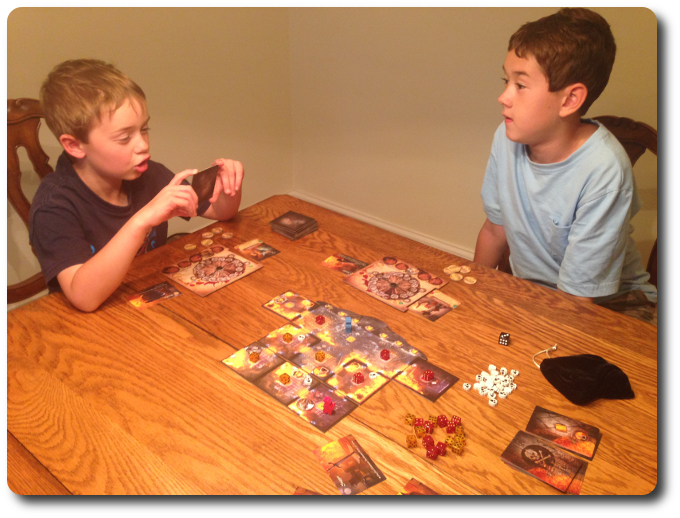
Two young pirate Child Geeks discuss where to place the new Room tile
The Parent Geeks understood the game much faster than the Child Geeks, but that didn’t mean they had an easier time playing it. Again, the same responses were observed, with the less experienced and non-gamers having a difficult time finding their footing and the more skilled and active players really enjoying themselves. According to one Parent Geek, “I don’t like pirates very much or games about pirates, but I’m really liking this one. Feels like a much better version of Pirates of the Caribbean.” While the theme resonated with many Parent Geeks, it was the challenging game play that pleased them most. As one Parent Geek put it, “This is a game that you really have to play as a team, but it’s easy to get cutoff and isolated, too. That creates tension and fun. I’m really liking this game.” When all the votes were in, the Parent Geeks were split. Those who enjoyed more challenging games voted to approve Dead Men Tell No Tales, while those Parent Geeks who enjoyed more casual games rejected it.
The Gamer Geeks, of course, had no issue learning and playing the game. They found the theme to be fun and they liked how players quickly became separated if they didn’t work together. They found the method in which the fire and skeletons spread about the ship to be plausible and manageable, with just the right level of difficulty to make it hard, but not impossible. According to one Gamer Geek, “This game appears to have benefited from the other games that came before it. I don’t have any problem with that and I think more developers should take note. If something works, keep using it.” Another Gamer Geek said, “I’m liking the theme and the game. I’m surprised pirates would rob an undead pirate ship, but hey, I guess the treasure is worth it.” What the Gamer Geeks did not like was what they referred to as “fiddly token management”. As one Gamer Geek said, “I feel like I’m a pirate accountant at times. I have to keep track of everything with tokens or the Player board. That takes me out of the game a bit, but I understand why it’s there.” The Gamer Geeks found this to be forgivable, if not sometimes annoying. The end result was full approval from the Gamer Geek group.
This is not a cooperative game I would put in front of a new player who was not already familiar with cooperative games. While players work together, they do not work side-by-side. That can be confusing, at least at first, and frustrating. The threat level in the game is always high and the proverbial clock ticks faster and faster, reducing the total amount of time the players have to win. Worse yet, if the players rush, they will become fatigued and further reduce their ability to assist. There is nothing more frustrating to a new player than being asked to learn a game and play it with very little chance of actually beating it. The sting of defeat is somewhat reduced since everyone loses at the table, but the Child Geeks had a really hard time keeping their cool.
So who is the game for? Not just for folks who like pirates, that’s for certain. Dead Men Tell No Tales combines several different game mechanisms seen in other cooperative games (Pandemic and Flash Point: Fire Rescue, come immediately to mind), but has a unique feel and game play of its own. The game is not easy, even at its easiest difficulty level. Players will have to hunt for treasure while simultaneously attempting to control the fire and the growing number of undead. That’s a lot to handle! Thematically speaking, I find the game pretty funny. These must be some very desperate pirates if they are willing to board a burning ship crewed by the undead damned. I mean, sheesh, there’s got to be a better way to make a gold piece.
I was very pleased with Dead Men Tale No Tales, and was not the least bit surprised by the mixed approvals from our Child Geeks and Parent Geeks. Both groups tend to gravitate towards games that are both thematic and casual. While Dead Men Tell No Tales is oozing with theme, its level of play is anything but casual. The initial draw of the game’s excellent artwork and backstory was quickly reduced to cinders when the players were burned too many times while playing the game. Not the case for the more advanced players in both groups, however.
Also not surprising was the light grumbling and eventual full approval by the Gamer Geeks. Dead Men Tell No Tales can feel fiddly at times with all the tracking and shifting of bits, but this is not uncommon in more advanced games. What the Gamer Geeks didn’t like was the number of times they had to play “accountant”. Dead Men Tell No Tales feels fiddly at times because it is. Each time you move Room tiles you have to do some math, roll dice and do math, pass tokens and do math. None of it’s hard, but the frequency can pull the player out of the game’s narrative. While this aspect of the game was not overly enjoyed by any of our groups, nor did it make the game fall flat. In order to keep the tension level high and the players challenged, the game must track the growing danger.
Dead Men Tell No Tales delivers what it promises. It’s a highly thematic Pirate game, downright difficult, and will challenge a groups ability to manage a lot of fires while also putting them out. If we were to judge a game on its ability to make players stop, discuss, and really think things through, then Dead Men Tell No Tales is a winner. While the game is about the undead, game play is most certainly lively.
This game was given to Father Geek as a review copy. Father Geek was not paid, bribed, wined, dined, or threatened in vain hopes of influencing this review. Such is the statuesque and legendary integrity of Father Geek.




Minion games are awesome,really like to play them.